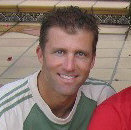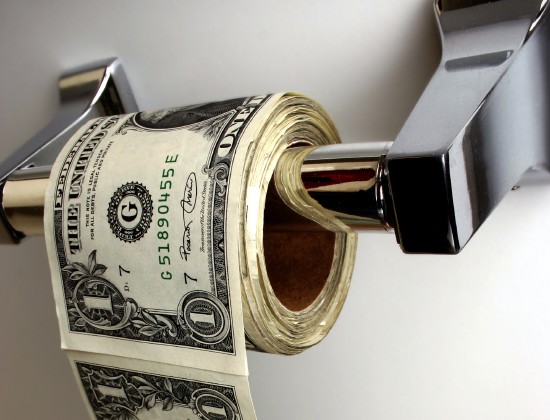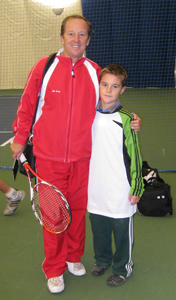 If the Ace of Spades is the only card you need, this article may be for you:
If the Ace of Spades is the only card you need, this article may be for you:
1. Bankroll: How much money should I invest? In tennis: If you are in it for pleasure, or just looking to have fun, don't invest any more than is fun to lose. If you're planning on making a career out of it, a more powerful bankroll may be more suitable.
2. Blinds: Forced bets. In tennis: These are the costs associated with tennis including: lessons; entry fees; equipment; travel; etc. Parents are often blind [chuckle-chuckle] as to these hidden costs which may add up over the course of development.
3. Draw: hoping to improve your hand with the cards that will come on the board. In tennis: hoping to improve your ranking with an easy draw.
4. Limit Poker: a game with fixed-size bets. In tennis: amateurism restrictions (can't take more than expenses).
6. Outs: Cards that can improve your hand. In tennis: an error by the opponent that can improve your chances of winning.
7. Pot Odds: The odds you are getting when you are drawing. In tennis: the odds of "making it" when you're first starting out (bad news: you are closer to ZERO).
8. Beginner Mistakes:
A. Playing too many hands. In tennis: playing too many tournaments; being involved in too many activities.
B. Playing above your bankroll. In tennis: spending above and beyond the level of comfort so as to cause internal stress and undesired pressures. Understand your level of comfort from the get-go and know when you've reached it and what you'll be willing to do going forward.
C. Becoming too emotional at the table. In tennis: Bad matches will happen. Losing is part of the game. Annoying opponents will have to be faced. Do not let your emotions sway your judgment.
D. Imitating other players. In tennis: trying to follow the pack in terms of chasing points, playing specific tournaments, joining this clinic or that, cherry-picking coaches or picking up negative attitudes ("just because so-and-so is doing it")
E. Overvaluing suited hands. In tennis: overqualifying yourself and underqualifying your opponents. Expect your opponent to improve every day. Work hard even if you're the best (or think you're the best). Even if you have the best hand (strokes) don't discount physical and mental toughness of the opponent which may TRUMP your hand.
F. Failing to keep your ego in check. In tennis: don't be naive and think you can be a guaranteed winner. Know when to walk away from a losing hand or a sport that's going nowhere. This is particularly important for parents. If you want it more for your kids than they do, then it's better to FOLD before you BUST. Don't stay in the game just because you've already spent $X, have a closet full of tennis clothes, a garage full of rackets and are hoping for a miracle. Identify losing hands (i.e., kids who simply don't want to pursue tennis and are not passionate about it) and walk away. Focus your energies elsewhere; it's really OK to not be a tennis player.
G. Banking on luck. In the long run, luck evens out; only skill remains as a deciding factor. "Edge" is the slight advantage one player has over another through more skill, larger stack or better position. In tennis: banking on short-cuts will be a loser; hard work is the only short-cut; try to improve your skill every day through focused practices. Don't bank on one good win and ignore your 100 bad losses. You're only as good as your worst loss.
H. Publicizing tells (mannerisms that reveal the true strength of a player's hand). In tennis: allowing emotions to send signals to your opponent regarding your level of comfort.
I. Losing focus. In tennis: allowing points to slip away for no reason; failing to work hard every day. As the expression goes: "if I don't practice one day, I know it; if I don't practice two days, the orchestra knows it; if I don't practice three days, the whole world knows it."
J. Becoming fixated on the charts. In tennis: focusing on rankings and draws
9. Skills:
A. Discipline (if you want to be good, you have to approach it like a job...a fun job but a job nonetheless)
B. Mental Toughness (both endeavors are about winning and bouncing back from losses)
C. Understanding Risk v. Rewards (understand what it takes to get somewhere, what you get when you get there and lost opportunity costs)
D. Ability to Think For yourself (don't follow the herd)
E. Ability to Grind (Doyle Brunson: “Limit [Texas] Hold 'em is like a job – the more hours you work, the more money you’ll make”)
F. Patience (looking at the long-term aspects of the game)
G. Observation (watching other players, learning and reading their strategies, likes/dislikes)
H. Knowing when to play and when to quit (see 8F, above)
I. Adaptability (knowing when to be aggressive and when to be defensive)
J. Ability to avoid being predicatable
K. Bluffing (sending out signals of confidence in order to make the other player nervous). As Buddha said: "your greatest weapon is in your opponent's mind."
10. Objectives:
A. Maximize Winning and Minimize Losses
B. Having Fun
 Thursday, December 1, 2011 at 05:52PM
Thursday, December 1, 2011 at 05:52PM  CAtennis
CAtennis 



